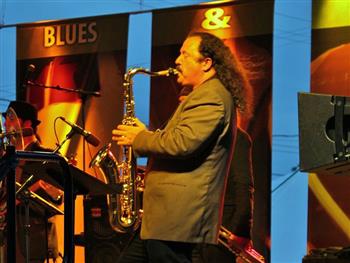
With Jazz Fest 2014 right around the corner, Murfreesboro is thinking jazzy thoughts. Thousands will gather May 2-3 on the Murfreesboro Public Square to hear various groups do their thing. Many associate jazz with steady grooves and improvisational solos, but what exactly is jazz?
To get a better handle on the style of music celebrated each May in Murfreesboro, the Pulse caught up with Jazz Fest committee member and longtime musician Karl Wingruber to tackle the question: What is jazz?
Murfreesboro Pulse: What is jazz?
Wingruber: The term is very elusive and hard to pin down.
Many of my musician comrades are very protective of the term “jazz” as it relates to the improvisational music of 1925-65, the “Golden Era” of jazz. Others dislike the use of the word, saying it it has racist implications, or that it’s an attempt by white culture to “claim ownership of music created by African-American musicians.” One thing is for sure—jazz music was created and nurtured by performers of all races. And its influence is everywhere. Many people don’t realize that the Big Band Era (1935-45) was actually the beginning of rock ‘n’ roll. Swing vocalists Frank Sinatra, Ray Eberle, June Christy, Ina Ray Hutton, and even the swing instrumentalists such as Gene Krupa, Benny Goodman, Harry James, Duke Ellington, Count Basie and hundreds of others were greeted with the same teen hysteria at shows that was later unleashed upon Buddy Holly, Chuck Berry, Elvis, The Beatles and other founding fathers of rock.
It’s in the music, too. Listen to early Elvis, Carl Perkins or Bill Haley, and what you hear underneath is swing. Etta James’ mammoth hit single “At Last” was first a million-seller for the Glenn Miller Orchestra.
After WWII came a fork in the road: jump blues and bop (also called “Bebop”). Jump blues would lead us into the 1950s R&B saxophone era, known as the “Honkers and Screamers,” which were essentially early rock ‘n’ roll bands fronted by saxophone players. This eventually gave rise to artists like Fats Domino, Little Richard and other such musical trailblazers. Bebop took jazz into a highly individualized improvisational setting and was not for dancing or entertainment. Charlie Parker and Dizzy Gillespie were its major practitioners.
In the 1960s John Coltrane and Sun Ra propelled us to the edge of the universe with their improvised solos.
Pop/rock music and jazz seemed to exist separately until Miles Davis, upon hearing Sly & the Family Stone, decided to create fusion, an attempt to unify the two. Many jazz musicians in the ’60s and ’70s were influenced by funk, Motown, blues, reggae, and other popular styles.
So, what is jazz? It’s the ultimate personal expression of an artist, requiring the highest caliber of musicianship. Despite the many recordings available, jazz should be experienced live. No album or mp3 download could possibly match the power of a big band swinging, or a soloist creating “in the moment.” Enjoy the masters of the past, but support the masters yet to come.













